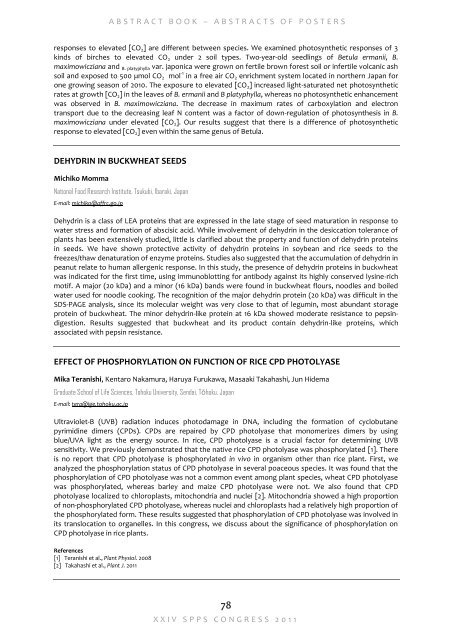1. Front Cover.cdr - CORE
1. Front Cover.cdr - CORE
1. Front Cover.cdr - CORE
You also want an ePaper? Increase the reach of your titles
YUMPU automatically turns print PDFs into web optimized ePapers that Google loves.
A B S T R A C T B O O K – A B S T R A C T S O F P O S T E R S<br />
responses to elevated [CO2] are different between species. We examined photosynthetic responses of 3<br />
kinds of birches to elevated CO2 under 2 soil types. Two-year-old seedlings of Betula ermanii, B.<br />
maximowicziana and B. platyphylla var. japonica were grown on fertile brown forest soil or infertile volcanic ash<br />
soil and exposed to 500 µmol CO2 mol -1 in a free air CO2 enrichment system located in northern Japan for<br />
one growing season of 2010. The exposure to elevated [CO2] increased light-saturated net photosynthetic<br />
rates at growth [CO2] in the leaves of B. ermanii and B platyphylla, whereas no photosynthetic enhancement<br />
was observed in B. maximowicziana. The decrease in maximum rates of carboxylation and electron<br />
transport due to the decreasing leaf N content was a factor of down-regulation of photosynthesis in B.<br />
maximowicziana under elevated [CO2]. Our results suggest that there is a difference of photosynthetic<br />
response to elevated [CO2] even within the same genus of Betula.<br />
DEHYDRIN IN BUCKWHEAT SEEDS<br />
Michiko Momma<br />
National Food Research Institute, Tsukubi, Ibaraki, Japan<br />
E-mail: michiko@affrc.go.jp<br />
Dehydrin is a class of LEA proteins that are expressed in the late stage of seed maturation in response to<br />
water stress and formation of abscisic acid. While involvement of dehydrin in the desiccation tolerance of<br />
plants has been extensively studied, little is clarified about the property and function of dehydrin proteins<br />
in seeds. We have shown protective activity of dehydrin proteins in soybean and rice seeds to the<br />
freezes/thaw denaturation of enzyme proteins. Studies also suggested that the accumulation of dehydrin in<br />
peanut relate to human allergenic response. In this study, the presence of dehydrin proteins in buckwheat<br />
was indicated for the first time, using immunoblotting for antibody against its highly conserved lysine-rich<br />
motif. A major (20 kDa) and a minor (16 kDa) bands were found in buckwheat flours, noodles and boiled<br />
water used for noodle cooking. The recognition of the major dehydrin protein (20 kDa) was difficult in the<br />
SDS-PAGE analysis, since its molecular weight was very close to that of legumin, most abundant storage<br />
protein of buckwheat. The minor dehydrin-like protein at 16 kDa showed moderate resistance to pepsindigestion.<br />
Results suggested that buckwheat and its product contain dehydrin-like proteins, which<br />
associated with pepsin resistance.<br />
EFFECT OF PHOSPHORYLATION ON FUNCTION OF RICE CPD PHOTOLYASE<br />
Mika Teranishi, Kentaro Nakamura, Haruya Furukawa, Masaaki Takahashi, Jun Hidema<br />
Graduate School of Life Sciences, Tohoku University, Sendai, Tōhoku, Japan<br />
E-mail: tera@ige.tohoku.ac.jp<br />
Ultraviolet-B (UVB) radiation induces photodamage in DNA, including the formation of cyclobutane<br />
pyrimidine dimers (CPDs). CPDs are repaired by CPD photolyase that monomerizes dimers by using<br />
blue/UVA light as the energy source. In rice, CPD photolyase is a crucial factor for determining UVB<br />
sensitivity. We previously demonstrated that the native rice CPD photolyase was phosphorylated [1]. There<br />
is no report that CPD photolyase is phosphorylated in vivo in organism other than rice plant. First, we<br />
analyzed the phosphorylation status of CPD photolyase in several poaceous species. It was found that the<br />
phosphorylation of CPD photolyase was not a common event among plant species, wheat CPD photolyase<br />
was phosphorylated, whereas barley and maize CPD photolyase were not. We also found that CPD<br />
photolyase localized to chloroplasts, mitochondria and nuclei [2]. Mitochondria showed a high proportion<br />
of non-phosphorylated CPD photolyase, whereas nuclei and chloroplasts had a relatively high proportion of<br />
the phosphorylated form. These results suggested that phosphorylation of CPD photolyase was involved in<br />
its translocation to organelles. In this congress, we discuss about the significance of phosphorylation on<br />
CPD photolyase in rice plants.<br />
References<br />
[1] Teranishi et al., Plant Physiol. 2008<br />
[2] Takahashi et al., Plant J. 2011<br />
78<br />
X X I V S P P S C O N G R E S S 2 0 1 1


